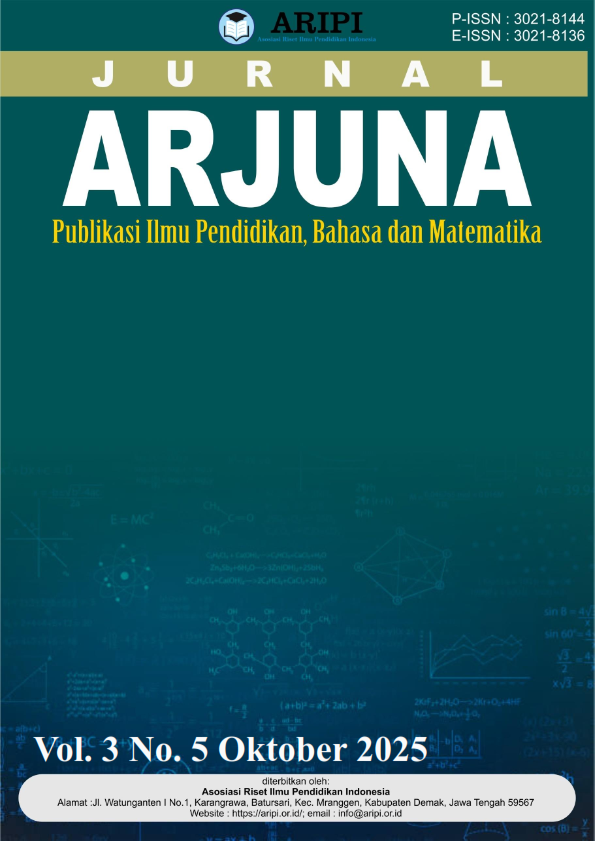Penerapan Model Pembelajaran PjBL untuk Meningkatkan Pemahaman Konsep Perubahan Wujud Benda pada Siswa Sekolah Dasar
DOI:
https://doi.org/10.61132/arjuna.v3i5.2271Keywords:
Project Based Learning, Understanding, Elementary School StudentsAbstract
This study aims to describe the application of the Project Based Learning (PJBL) learning model in improving the understanding of the concept of changes in the state of matter in Elementary School students. The background of this study is based on the low understanding of students on the material of changes in the state of matter, which can have an impact on the weak mastery of scientific concepts as a whole. The method used is qualitative research with a library research approach, where data is collected through analysis of various scientific literature, journals, and relevant academic sources. The results of the study indicate that PJBL is a learning model that emphasizes the active involvement of students in real projects, from designing, implementing, to presenting the results. The application of PJBL in the topic of changes in the state of matter encourages students to experience scientific processes such as melting, evaporating, freezing, and condensing directly through simple experiments. PJBL not only improves students' conceptual understanding, but also develops science process skills, critical thinking, collaboration, communication, and responsibility. In its implementation, PJBL follows certain stages starting from determining essential questions to reflection. Despite facing several challenges such as limited time, facilities, and teacher readiness, solutions can be sought through effective planning and professional training. Thus, PJBL has proven to be the right approach in improving the quality of science learning in elementary schools, especially in strengthening students' understanding of the concept of changes in the state of objects in a comprehensive and meaningful manner.
Downloads
References
Abdul Rauf, Fahyuddin, F., & Dahlan, D. (2023). Penerapan model pembelajaran berbasis masalah pada materi perubahan wujud dan suhu benda untuk meningkatkan keterampilan berpikir kritis dan pemahaman konsep peserta didik kelas V SD Negeri 6 Kendari. Jurnal Biofiskim: Pendidikan dan Pembelajaran IPA, 5(2). https://doi.org/10.33772/biofiskim.v5i2.572
Arif Rahman Hakim. (2024). Pengaruh model Project Based Learning (PjBL) terhadap hasil belajar IPA siswa kelas V sekolah dasar. Galaxy: Jurnal Pendidikan MIPA dan Teknologi, 1(1), 1–6. https://doi.org/10.59923/galaxy.v1i1.140
Damarianty, D. (2022). Meningkatkan hasil belajar siswa menggunakan metode presentasi materi tindakan manusia memelihara alam kelas III SD Negeri 09 Batu Onap. Bestari: Jurnal Pendidikan dan Kebudayaan, 3(2), 66–71. https://doi.org/10.46368/bjpd.v3i2.901
Fatimah, S., Anggraini, R., & Riswari, L. A. (2024). Peningkatan hasil belajar siswa melalui model pembelajaran Project Based Learning (PjBL) pada siswa kelas IV sekolah dasar. Jurnal Basicedu, 8(1), 319–326. https://doi.org/10.31004/basicedu.v8i1.7109
Gumala Dewi, S. P., Suriani, A., & Nisa, S. (2024). Penerapan literasi sains untuk meningkatkan kualitas pembelajaan IPA di sekolah dasar. Journal of Practice Learning and Educational Development, 4(2), 95–99. https://doi.org/10.58737/jpled.v4i2.282
Herowati, H. (2023). Analisis penerapan model pembelajaran Project Based Learning (PjBL) materi perubahan fisika dan kimia terhadap keaktifan belajar peserta didik. Journal of Innovation Research and Knowledge, 2(12), 4603–4612. https://doi.org/10.53625/jirk.v2i12.5672
Ilman Nadif Filsafah, Wilarso, W., Saepudin, A., & Dharmanto, A. (2024). Analisis perpindahan panas terhadap penurunan suhu air panas pada gelas dengan material yang berbeda. Metalik: Jurnal Manufaktur, Energi, Material Teknik, 3(1), 5–9. https://doi.org/10.22236/metalik.v3i1.14272
Israwaty, I., Hasan, K., & Khadijah, K. (2023). Penerapan model pembelajaran Project Based Learning (PjBL) dalam meningkatkan hasil belajar siswa pada materi perubahan wujud benda kelas V UPTD SD Negeri 57 Parepare. Phinisi Integration Review, 6(3), 447. https://doi.org/10.26858/pir.v6i3.48541
Kresnadi, K. A., Margunayasa, I. G., & Widiana, I. W. (2022). Video pembelajaran perubahan wujud benda pada pembelajaran IPA kelas V SD Gugus III Kecamatan Buleleng. Mimbar Pendidikan Indonesia, 2(3), 241–254. https://doi.org/10.23887/mpi.v2i3.44478
Muh Ali, A., Satriawati, S., & Nur, R. (2023). Meningkatkan hasil belajar IPA menggunakan metode eksperimen kelas VI sekolah dasar. PTK: Jurnal Tindakan Kelas, 3(2), 114–121. https://doi.org/10.53624/ptk.v3i2.150
Nurhayati, N. (2022). Peningkatan pemahaman perubahan wujud benda dalam pembelajaran sains melalui metode eksperimen. Pedagogika, 211–228. https://doi.org/10.37411/pedagogika.v13i2.1838
Pinasthika, R. P., & Kaltsum, H. U. (2022). Analisis penggunaan metode eksperimen pada pembelajaran IPA di sekolah dasar. Jurnal Basicedu, 6(4), 6558–6566. https://doi.org/10.31004/basicedu.v6i4.3304
Puji Utami, R. (2022). Penerapan model Project Based Learning (PjBL) dalam meningkatkan keaktifan siswa. Jurnal Bimbingan dan Konseling Pandohop, 2(1), 9–15. https://doi.org/10.37304/pandohop.v2i1.4308
Putri, N. M., Hakim, L. E., & Ristanto, R. H. (2024). Studi literatur penerapan Project-Based Learning (PjBL) pada pembelajaran kimia. Ideguru: Jurnal Karya Ilmiah Guru, 10(1), 433–442. https://doi.org/10.51169/ideguru.v10i1.1251
Rahayuningsih, S., Nurasrawati, & Nurhusain, M. (2022). Komparasi efektivitas model pembelajaran Project Based Learning (PjBL) dan konvensional: Studi pada siswa menengah pertama. Kognitif: Jurnal Riset HOTS Pendidikan Matematika, 2(2), 118–129. https://doi.org/10.51574/kognitif.v2i2.654
Salsabila, L. A., Ngatman, & Chamdani, M. (2024). Penerapan Project Based Learning (PjBL) untuk meningkatkan hasil belajar IPA tentang perubahan wujud benda akibat kalor pada siswa kelas V. Kalam Cendekia: Jurnal Ilmiah Kependidikan, 12(1). https://doi.org/10.20961/jkc.v12i1.76168
Selasmawati, & Lidyasari, A. T. (2023). Model pembelajaran Project Based Learning (PjBL) dalam meningkatkan kemampuan berpikir kritis sekolah dasar guna mendukung pembelajaran abad 21. Jurnal Penelitian Pendidikan IPA, 9(11), 1165–1170. https://doi.org/10.29303/jppipa.v9i11.4776
Sukma, I. (2023). Penerapan model pembelajaran PjBL untuk meningkatkan hasil belajar IPA siswa kelas VI SD. Pendas: Jurnal Ilmiah Pendidikan Dasar, 8(2), 1567–1578. https://doi.org/10.23969/jp.v8i2.9702
Sumilat, J. M., Ilam, D., Pangemanan, M. V., Mangantibe, A. C. M., Mukuan, E. B., & Kumontoy, N. (2023). Analisis implementasi model PjBL (Project Based Learning) di sekolah dasar. Jurnal Basicedu, 7(6), 3980–3988. https://doi.org/10.31004/basicedu.v7i6.6557
Susilo, M. J., Dewantoro, M. H., Yuningsih, Y., Burhanuddin, M. A., & Wahab, A. (2022). Jurnal belajar sebagai refleksi siswa sekaligus evaluasi guru selama proses pembelajaran. Briliant: Jurnal Riset dan Konseptual, 7(1), 116. https://doi.org/10.28926/briliant.v7i1.914
Tri Dina Kandi, Saputri, T. R., & Syahrial, S. (2024). Upaya meningkatkan hasil belajar IPA pada materi perubahan wujud benda melalui metode eksperimen SDN 054906 Tebasan Lama. Guruku: Jurnal Pendidikan dan Sosial Humaniora, 2(2), 19–30. https://doi.org/10.59061/guruku.v2i2.632
Zuhaida, A., & Mubtasyiroh, Z. (2022). Efektivitas model Project Based Learning dengan pendekatan inkuiri berbasis lingkungan terhadap hasil belajar IPA. Jurnal IPA & Pembelajaran IPA, 6(2), 119–129. https://doi.org/10.24815/jipi.v6i2.24440
Downloads
Published
How to Cite
Issue
Section
License
Copyright (c) 2025 Jurnal Arjuna : Publikasi Ilmu Pendidikan, Bahasa dan Matematika

This work is licensed under a Creative Commons Attribution-ShareAlike 4.0 International License.






